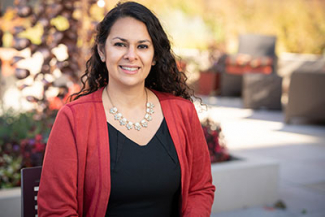
On Tuesday, March 9, Dr. Narjust Duma presented "Who Me, Biased? The Reality and the Solutions to Unconscious Bias in Medicine," during which she defined several types of unconscious bias, explained the impact of these negative associations, and discussed how to take action against implicit bias by becoming an active ally. In addition to serving as an assistant professor of medicine and a thoracic medical oncologist at the UW School of Medicine and Public Health, Dr. Duma is co-founder of the #LatinasinMedicine Twitter community, which has nearly 6,000 followers.
Watch an archived recording of the presentation
To begin her presentation, Dr. Duma asked her audience to participate in a word association exercise where she asked them to picture a governor, a couple eating at a restaurant, and a community leader. She then rhetorically probed the audience asking if they imagined a governor who is a woman of color, a same sex couple sharing a meal, or a middle-aged, white woman leading her community. Dr. Duma used these examples to demonstrate how unconscious bias can operate outside of a person’s awareness.
Dr. Duma went on to define unconscious biases as negative associations that can lead people to see danger, under qualification, and faults where they do not exist. There are many types of unconscious bias, and Dr. Duma explained the following in her talk:
- affinity bias — the unconscious tendency to get along with others who are like us
- contrast bias — when one thing is compared to another rather than judging the whole on its merits
- gender bias — when it is thought that one gender may be better for a role than another based on stereotyping
- horns bias — when one negative characteristic is focused on while all the positive characteristics are ignored
Next, she described how these biases impact medicine. Dr. Duma shared her own experiences with implicit bias from patients, stating, “When I enter a patient’s room, my age, my gender, my ethnicity, and my accent enter before any of my titles.” On the other hand, when physicians demonstrate bias against people of color, they are less likely to provide appropriate treatment for pain and blood clot events, more likely to have decreased physician-patient communication, and more likely to exhibit differences in clinical decision making. Additionally, in academic medicine, implicit bias during residency, fellowship, or faculty interviews can be fed by school pedigree, immigration status, gender and sexual orientation, and socioeconomic status among others.
Toward the end of her talk, Dr. Duma gave her audience a “toolkit” that included strategies to counteract unconscious bias. The first was to question stereotypes. Second, she said to diversify your experiences by hearing stories from others and learning about their experiences. The third tool was to use deliberative reflection to think about ways you can be more aware of implicit biases. The fourth and final strategy was not to trust your “gut feeling” about people because these feelings are associated with unconscious bias.
To conclude her lecture, Dr. Duma suggested a number of ways to become an active ally for underrepresented groups. She said to be mindful of people’s pronouns and stop using microaggressions, which are either unintentional or intentional statements or actions that communicate discrimination toward marginalized groups. Allies will also use diverse pictures and experiences during presentations, and they will advocate for the inclusion of women, people of color, and members of other underrepresented groups as keynote speakers and panelists. Finally, active allies will use their privilege to create equity by bringing others to the table.
This guest lecture was presented by Women in Science & Engineering Leadership Institute (WISELI), Alliance of Women in Alzheimer’s Research in Wisconsin (AWARE-WI), and the Wisconsin Alzheimer’s Disease Research Center Research Education Component (REC).
Story by Kate Vickerman, Science Writing Intern
- Log in to post comments



